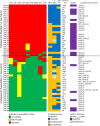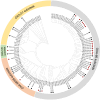Molecular genotyping reveals multiple carbapenemase genes and unique blaOXA-51-like (oxaAb) alleles among clinically isolated Acinetobacter baumannii from a Philippine tertiary hospital
- PMID: 39327611
- PMCID: PMC11426070
- DOI: 10.1186/s41182-024-00629-w
Molecular genotyping reveals multiple carbapenemase genes and unique blaOXA-51-like (oxaAb) alleles among clinically isolated Acinetobacter baumannii from a Philippine tertiary hospital
Abstract
Background: Acinetobacter baumannii continued to be an important Gram-negative pathogen of concern in the clinical context. The resistance of this pathogen to carbapenems due to the production of carbapenemases is considered a global threat. Despite the efforts to track carbapenemase synthesis among A. baumannii in the Philippines, local data on its molecular features are very scarce. This study aims to characterize A. baumannii clinical isolates from a Philippine tertiary hospital through genotyping of the pathogen's carbapenemase genes.
Methods: Antibiotic susceptibility profiling, phenotypic testing of carbapenemase production, and polymerase chain reaction assays to detect the different classes of carbapenemase genes (class A blaKPC, class B blaNDM, blaIMP, blaVIM, and class D blaOXA-23-like, blaOXA-24/40-like, blaOXA-48-like, blaOXA-51-like, ISAba1-blaOXA-51-like, blaOXA-58-like) were performed in all collected A. baumannii, both carbapenem resistant and susceptible (n = 52).
Results: Results showed that the majority of the carbapenem-resistant strains phenotypically produced carbapenemases (up to 84% in carbapenem inactivation methods) and possessed the ISAba1-blaOXA-51-like gene complex (80%). Meanwhile, both carbapenem-resistant and carbapenem-susceptible isolates possessed multi-class carbapenemase genes including blaNDM (1.9%), blaVIM (3.9%), blaOXA-24/40-like (5.8%), blaOXA-58-like (5.8%), blaKPC (11.5%), and blaOXA-23-like (94.2%), which coexist with each other in some strains (17.3%). In terms of the intrinsic blaOXA-51-like (oxaAb) genes, 23 unique alleles were reported (blaOXA-1058 to blaOXA-1080), the majority of which are closely related to blaOXA-66. Isolates possessing these alleles showed varying carbapenem resistance profiles.
Conclusions: In summary, this study highlighted the importance of molecular genotyping in the characterization of A. baumannii by revealing the carbapenemase profiles of the pathogen (which may not be captured accurately in phenotypic tests), in identifying potent carriers of transferrable carbapenemase genes (which may not be expressed straightforwardly in antimicrobial susceptibility testing), and in monitoring unique pathogen epidemiology in the local clinical setting.
Keywords: Acinetobacter baumannii; oxaAb; Carbapenem resistance; Carbapenemase; Philippines; β-lactamase.
© 2024. The Author(s).
Conflict of interest statement
The authors declare that they have no competing interests.
Figures



Similar articles
-
Co-existence of blaOXA-23 and blaNDM-1 genes of Acinetobacter baumannii isolated from Nepal: antimicrobial resistance and clinical significance.Antimicrob Resist Infect Control. 2017 Feb 7;6:21. doi: 10.1186/s13756-017-0180-5. eCollection 2017. Antimicrob Resist Infect Control. 2017. PMID: 28191309 Free PMC article.
-
Molecular characteristics of carbapenem-resistant Acinetobacter spp. from clinical infection samples and fecal survey samples in Southern China.BMC Infect Dis. 2019 Oct 28;19(1):900. doi: 10.1186/s12879-019-4423-3. BMC Infect Dis. 2019. PMID: 31660862 Free PMC article.
-
Dissemination of blaOXA-23, blaOXA-24, blaOXA-58, and blaNDM-1 Genes of Acinetobacter baumannii Isolates from Four Tertiary Hospitals in Thailand.Microb Drug Resist. 2018 Jan/Feb;24(1):55-62. doi: 10.1089/mdr.2016.0248. Epub 2017 Jun 8. Microb Drug Resist. 2018. PMID: 28594634
-
Distribution pattern of carbapenemases and solitary contribution to resistance in clinical strains of Acinetobacter baumannii.Ann Palliat Med. 2021 Aug;10(8):9184-9191. doi: 10.21037/apm-21-1805. Ann Palliat Med. 2021. PMID: 34488404
-
Molecular epidemiology of carbapenem-resistant gram-negative bacilli in Ecuador.BMC Infect Dis. 2024 Apr 6;24(1):378. doi: 10.1186/s12879-024-09248-6. BMC Infect Dis. 2024. PMID: 38582858 Free PMC article.
Cited by
-
Genetic Diversity of Carbapenemases-producing Acinetobacter baumannii Isolates at a Tertiary Teaching Hospital in Western India.Int J Appl Basic Med Res. 2025 Apr-Jun;15(2):91-97. doi: 10.4103/ijabmr.ijabmr_498_24. Epub 2025 Apr 7. Int J Appl Basic Med Res. 2025. PMID: 40343241 Free PMC article.
-
Detection of a new blaOXA-51-Like variant (blaOXA-1328) and a novel sequence type (ST3457/2790) in Acinetobacter baumannii isolated from community sewage and an incinerator surface in Nigeria.BMC Res Notes. 2025 Aug 6;18(1):345. doi: 10.1186/s13104-025-07384-z. BMC Res Notes. 2025. PMID: 40770653 Free PMC article.
References
-
- Michalopoulos A, Falagas ME. Treatment of Acinetobacter infections. Expert Opin Pharmacother. 2010;11(5):779–88. 10.1517/14656561003596350. - PubMed
-
- Department of Health [Internet]. Antimicrobial Resistance Surveillance Program Annual Report 2022 [cited 2023 March 13]. Available from: https://arsp.com.ph/download/1864/?tmstv=1696147644
Grants and funding
LinkOut - more resources
Full Text Sources
Miscellaneous
